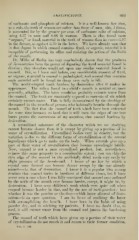Page 599 - My FlipBook
P. 599
AMELIFICATION. 609
of carbonate and phosphate of calcium. It is a well-known fact that,
as a rule, the teeth of women are softer than those of men ; this, I think,
is accounted for by the greater per cent, of carbonate salts of calcium,
being 4.37 in man and 8.88 in woman. There is also found more
" organic," or fixed, material in the teeth of woman than in man—5.97
in the former, as against 3.59 in the latter. We have already seen that
in that degree in which enamel contains fixed, or organic, material is it
incapable of performing its office and resisting the action of the fiuids
of the mouth.
Dr. Miller of Berlin has very conclusively shown that the products
of fermentation have the power of digesting the fixed material found in
dentine ; they therefore would act upon any similar material found in
enamel. But, as I have said before, any considerable amount of fixed,
or organic, material in enamel is pathological, and enamel that contains
such material will be found to decay very early in life.
The newly-erupted tooth hardens by desiccation after it makes its
appearance. The saliva found in a child's mouth is neutral or, more
generally, alkaline. The latter condition probably extracts water from
the enamel. The teeth are constantly exposed to currents of air, which
certainly extract water. This is fully demonstrated by the checkhu/ of
the enamel in the mouths of persons who habitually breathe through the
mouth. The fact that the enamel of teeth which have been extracted
for some time becomes so hard that it will turn the edges of our best
burrs proves the correctness of my assertion, that enamel hardens by
desiccation.
A crystallized substance of the character which we are studying
cannot become denser than it is except by giving up a portion of its
water of crystallization. Crystallized bodies vary in density, but the
variation is due to the different forms of crystallization of the several
ingredients which go to make up the body. When crystals give up a
part of their water of crystal ization they become exceedingly brittle.
Now, enamel is not a pure crystallized product, but, nevertheless,
evinces this same property to a considerable extent ; you can chip the
thin edge of the enamel in the artificially dried tooth very easily by
slight pressure of the thumb-nail. I know of no law by which a
crystal once formed can become denser except l)y the one already
named—viz. that of desiccation. I know it is a popular idea among
dentists that enamel varies in hardness at different times, but I have
never seen a case where I was fully convinced that enamel once softened
by the acids of the mouth ever became harder, except, it might be, by
tlesiccation. I have seen children's teeth which were quite soft when
erupted become harder in finie, and by the use of tooth-powders ; but
whether it M^as the powder or the time—which latter allowed of desic-
cation—is an open question. I am in favor of crediting the latter
with accomplishing the benefit. I have been in the habit of using
powder dry, and so advising my patients. I have no doubt that, so
used, it will extract water from the enamel and hasten the hardening
process.
The enamel of teeth which have given up a portion of their water
of crystallization do not resorb it and return to their former condition.
Vol. L—39.


